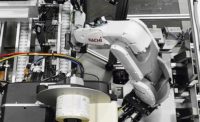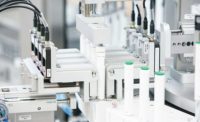Under the laws of cricket, it is illegal for players to rub any substance other than saliva and sweat onto the ball, let alone scuffing it with their fingernails. Similarly, strict rules apply to the manufacturing of cricket balls.
Kookaburra Sport Group of Melbourne, Australia, has been following those rules since 1890. Kookaburra is the leading maker of cricket balls in Australia. The company’s two- and four-piece balls are used in all game formats, at all levels, all over the world.
Making cricket balls is a labor-intensive process, involving a lot of hand stitching. Automating simpler parts of the process, such as pressing, trimming and machine tending, would therefore be a big help. To get that done, Kookaburra turned to M.A.P Services, a distributor for robot supplier TM Robotics in Ravenhall, Australia.
To make cricket balls, workers place covers—the outside leather of cricket balls—into trays after they are pressed into hemispherical shapes. Workers constantly bend and twist to fill the trays. A tray is completed every couple of minutes.
The trays are then placed into a rack and moved to the next station. Here, workers pick and place each cover into a trimming machine, which uses a sharp blade to remove excess leather. Not only is this process repetitive, but it also puts workers at risk for major hand injuries by being so close to a moving blade.
To automate this process, M.A.P engineers suggested using a robot and an automated tray handling system to load and unload the trimmer. Full trays of covers are placed into the handling system, which automatically supplies the trays to a TVL 700 six-axis robot, which loads and unloads the trimming machine. With this setup, only one worker is needed to load a set of trays every 20 to 25 minutes.
M.A.P designed an automatic racking system, in which six trays carrying 80 to 90 covers are placed onto a conveyor. Because the covers are scattered on the trays in random locations, a vision system is required to ensure that the robot can accurately decipher where each cover is and how to pick it up.
The vision system uses high-speed cameras to continuously capture 3D images of the covers. Using intelligent software, the system can process these images and identify the exact position of each cover. The system then determines the most logical order to pick up each cover and with submillimeter accuracy.
M.A.P engineers suggested the TVL 700 robot for this application due to its high speed and articulated movement. These features ensure easy changes of direction, without limiting the range of motion.
It is the quickest robot in TM Robotics’ TVL range, with a maximum reach of 700 millimeters and a maximum payload of 4 kilograms.
“This application is about automating processes, speeding up production and getting more consistent results,” says Shane Gallagher, director of M.A.P Services. “The manufacturing process needs to be fast, but safe, as it includes a pressing machine that has a hydraulic plunger and a blade. Ensuring operators are away from the blade removes the risk of serious injury.”
Due to the success of this project, Kookaburra placed an order for another machine tending application, with some slight differences. “For the second robotic application, we used an expanded I/O module,” says Gallagher. “One robot now performs six processes, which is rare, but its flexibility and the I/O module allow us to do more actions.”
The new application involves a machine that waterproofs the ball. The covers must come out of this machine in 8 seconds; otherwise it freezes. “The TVL 700 is ideal for this, as it can perform this action at a high speed in a confined space,” says Gallagher. “And with the expanded I/O module, it is able to communicate with other equipment to help complete the more complex cycle.”
To see a video of the machine in production, click here. For more information on robots, visit www.tmrobotics.com.





